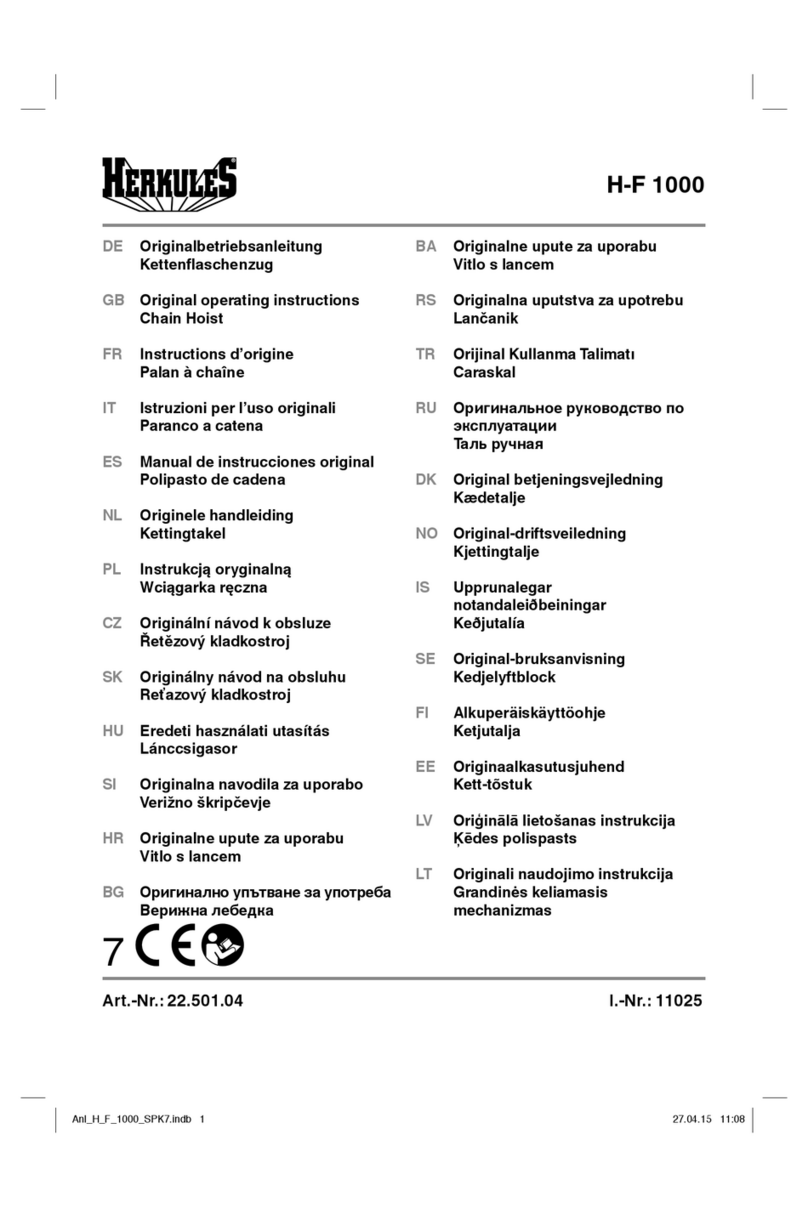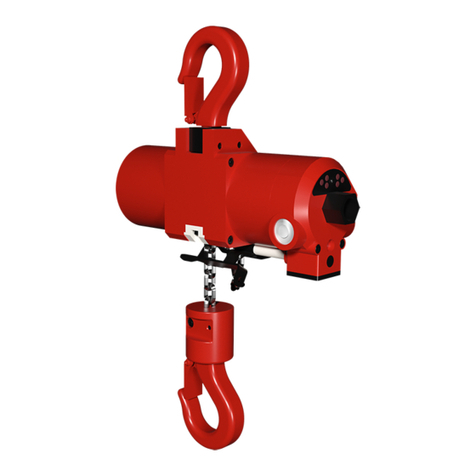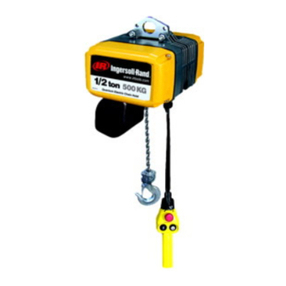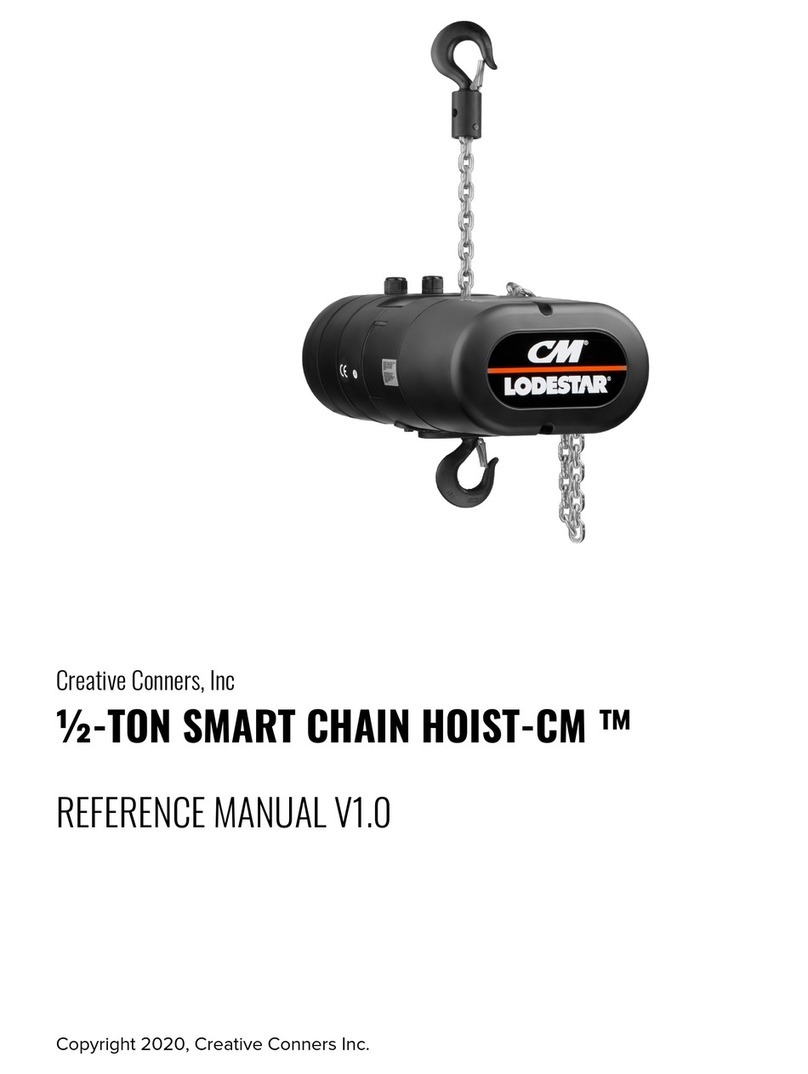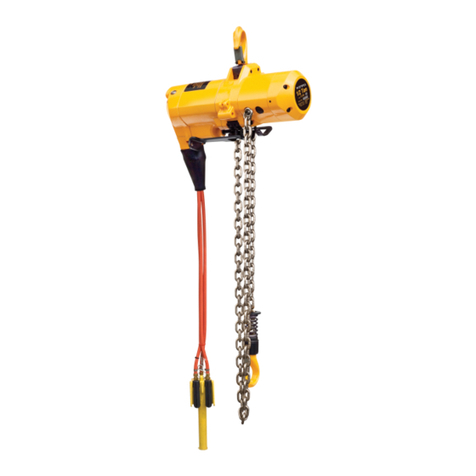
www. gerlif ng.com
Unit 1, 'ƌĞĞŶƐĮeld Industrial Estate,
Willowburn Avenue,
ALNWICK, NE66 2DG
Email: info@ gerli ing.com
www.tigerlifting.com
Page 3 of 18
Safety Instructions
Improper use of chain blocks could result in death or serious injury, to avoid these hazards:
Always be familiar with chain block operating controls, procedures and warnings.
Always allow only competently trained people to operate the hoist.
Always operate a hoist only if you are physically fit.
Always inspect the hoist before use.
Always let the authorized personnel inspect the hoist periodically.
Always make sure the chain block suspension hook is se curely attached to a suitable support. The selection and calculation
of the appropriate supporting structure are the responsibility of the operating company.
Always maintain a firm footing or be otherwise secured when operating the chain block .
Always make sure that load slings or other approved sling attachments are properly sized and seated in the hook saddle.
Only approved and certified lifting tackle must be used.
Always make sure that the hook latch, is closed and not supporting any part of the load.
Always make sure that the load is free to move and will clear all obstructions.
Always take up slack chain carefully, check load balance, then lift a few centimetres and check to be sure the brake will hold
the load and that attachments to the load are firmly seated.
Always avoid any swinging of the load or load hook.
Always protect load chain from weld spatter or other damaging contaminants.
Always report any malfunction, unusual performance or damage of lifting equipment to the appropriate person promptly .
Always inspect the chain block regularly, replace damaged or worn parts and keep appropriate records of maintenance.
Always use genuine Tiger parts when repairing the chain block .
Always apply lubricant to the load chain as recommended in this manual.
Always make sure that you and others are clear of the load before lifting begins and stay clear of the suspended load.
Always warn personnel of your intention to move a load in their area. The operator may start moving the load only after it has
been attached correctly and all persons are clear of the danger zone.
Always make sure that the chain length is long enough for the intended job.
Always check that the hook latches are in proper working order before use (Refer to Chapter 4). Replace missing, damaged or
broken hook latches.
Always be sure that the hoist's rated capacity, which is found on the hoist's name plate /label and forged into the hooks, is in
excess of the weight of the load.
Always keep the load from hitting the chain.
Always use two hoists which have rated capacities equal to or more than the load to be lifted whenever you must use two
hoists to lift a load. This will provide adequate protection in the event that a sudden load shift or failure of one hoist
occurs.
Always check the brake before use.
Always check for loose or missing parts before use.
Always lubricate the hoist regularly.
Always pay attention to the load at all times when operating the hoist.
Always secure a hoist and loads properly after use.
Always consult the manufacturer or your dealer if you plan to use a hoist in a dusty, moist or greasy environment.
Always consult the manufacturer or your dealer if you plan to use a hoist in an excessively corrosive environment.
Always operate the hoist with manual power.
Always stop using the hoist immediately in case of functional defects or abnormal operating noise.
Always observe that the chain hangs straight (without twists) from chain block to lower hook.
Always lift in a straight line from hook to hook.
Always make sure the chain block is free to swivel on the upper hook.
Always fit load chains which have been approved by the manufacturer.
www. gerlif ng.com
Unit 1, 'ƌĞĞŶƐĮeld Industrial Estate,
Willowburn Avenue,
ALNWICK, NE66 2DG
Email: info@ gerli ing.com
www.tigerlifting.com
Page 4 of 18
Improper use of chain blocks could result in death or serious injury, to avoid these hazards:
Never attempt to lift more than the rated load capacity (WLL) of the suspension and the supporting structure.
Never allow your attention to be diverted from operating the chain block .
Never attempt to operate this equipment under the influence of alcohol or drugs.
Never wrap the load chain around the load and hook onto itself as a sling/choker chain.
Never insert the point of the hook into a chain link.
Never lift a load if binding prevents equal loading on the load chain.
Never let the load swing or come into contact with other objects.
Never use the chain block to lift, lower, support or transport people.
Never lift a load over people.
Never work near or under hoisted loads.
Never use a damaged chain block or a chain block that is not working correctly.
Never use a chain block which has been taken out of service until it has been properly repaired or replaced.
Never use a hoist if the hook latch is missing or broken (if one is intended to be fitted).
Never splice load or hand chain by using pins, bolts, screw drivers or similar between links.
Never attempt to lengthen the load chain or repair damaged load chain.
Never force a hook or chain into place by hammering.
Never use the chain block with twisted, kinked, damaged, stretched or worn chain.
Never swing a suspended load.
Never support a load on the tip of the hook.
Never suspend a load for an extended period of time.
Never leave a suspended load unattended.
Never run the load chain over a sharp edge ; use a sheave .
Never weld or cut a load suspended by a hoist.
Never use the hoist chain as a welding electrode or allow the chain or hook to be touched by a live welding electrode.
Never allow the chain or hook to be used as an earth for welding.
Never use the hoist with rusty chain.
Never run the lower hook block into the chain block frame or bring the load in contact with the chain block . Case and/or
chain guide damage may result.
Never operate the chain block beyond limits of load chain travel or run the hook assembly into the frame of the block.
Never use the chain stop as an operational limit device.
Never operate a hoist if chain is jumping, if there is excessive noise, or if jamming, overloading or binding occurs.
Never use a hoist without both load chain anchoring points correctly fitted.
Never use a hoist without a name plate /label or with illegible name plate /label .
Never use modified or deformed hooks (refer to Chapter 4).
Never use a motor to operate a manual chain block .
Never use a hoist near fire or where hot objects may touch it.
Never use the hoist in temperatures below -40°C (-40°F) or above +50 °C (+122 °F).
Never adjust or repair a chain block unless qualified to perform chain block maintenance.
Never perform maintenance on the hoist while it is supporting a load
Never use the unit for pulling free a jammed load
Never allow loads to drop when the chain is in a slack condition (danger of chain breakage and shock loading ).
Never move the load into areas which are not visible to the operator.
Never suspend more than one load lifting attachment in the hook of the hoist.
Never reach into moving parts.
Never throw a hoist or allow the unit to fall from height. Always place it properly on the ground.
Never heat treat nor weld any part of the chain block , especially the load chain.

